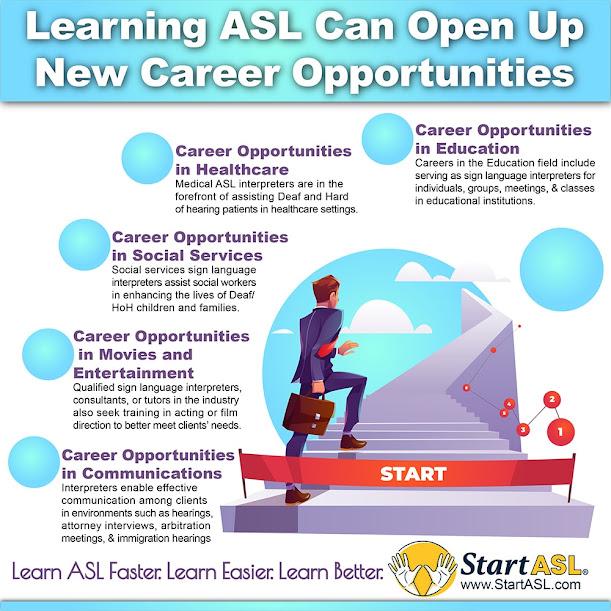Unlock Your Potential! Learn American Sign Language and Discover Career Paths
In case you’re deciding to learn American Sign Language (ASL), you are part of a growing trend. The use of sign language has become significantly common all over the world. A lot more people are using the language as a communication tool or studying it as an educational subject. In the U.S. and Canada, close to 250,000 - 500,000 people spanning various ages and backgrounds use sign language as their first language. In the U.S. nowadays, ASL is the third most commonly used language after English and Spanish.
Sign language is a largely manual form of communication usually made use of by those people who are Deaf or Hard of hearing. Sign language is not universal in form. Deaf or Hard of hearing (Deaf/HoH) people from different countries communicate in distinct sign language varieties. The gestures or symbols utilized in sign languages are structured linguistically with distinctive grammar as well as word orders. Every gesture in a sign language is called a sign. And each sign has 5 basic elements which are used during signed communication. These include hand shape, hand position, hand movement, palm orientation, and non-manual elements such as facial expressions and body posture.
As it is the most commonly used sign language in the U.s., it is vital to learn ASL for a number of good reasons. To start with, being adept in the use of ASL helps you make contact with a wide range of hearing, Hard of hearing, and also Deaf individuals. These comprise of students in mainstream schools and Deaf school or college programs, and even Deaf/HoH entrepreneurs and people of your community. In addition, fluency in ASL raises the quality and depth of family interactions for hearing people who have Deaf/HoH relatives.
Apart from these benefits, as more Deaf/HoH and hearing individuals learn sign language, the range of careers available to people who have this skill is growing. The U.S. Bureau of Labor Statistics says that the job of a sign language interpreter keeps growing a lot more quickly than ever before, with a 19% growth rate expected in the next 5 years.
Work Opportunities in Education
Jobs in this field include being sign language interpreters for individuals, groups, conventions, and also classes in universities. What’s more, ASL-proficient instructors are in demand at Deaf schools, special education programs, and post-secondary schools such as Gallaudet University and the National Technical Institute for the Deaf. A relevant profession involves working with Deaf-blind students employing a tactile type of sign language.
Job Opportunities in Healthcare
Work paths for those who learn sign language are also expanding in healthcare. Medical ASL interpreters are in the lead of helping Deaf and Hard of hearing patients in healthcare settings. They work with several communication methods, such as sign language and speech reading, also referred to as lip reading.
Sign language interpreters are needed to break the language barrier and effectively treat patients. And to ensure a high-quality and safe interpreting experience for Deaf/HoH patients, all of the pro ASL interpreters are certified by the Registry of Interpreters for the Deaf (RID).
Career Opportunities in Communications
Interpreters allow effective communication among clients in the subsequent settings:
· conferences and formal meetings;
· business gatherings like exhibitions, staff meetings, and product launches;
· criminal justice proceedings like police interrogations, courtroom hearings, attorney interviews, arbitration meetings, and also immigration hearings (work conducted in these settings is called public service interpreting); and
· community-based functions and assignments.
The job of sign language interpreters may also involve translating documents into sign language. This task, known as sight translation, is the rendering of a written text into ASL or even another sign language and it is often done in real-time.
Career Opportunities in Movies and Entertainment
Effective interpreting in T.V., films, or the theatre requires not just knowledge of sign language. It requires an understanding of the entertainment sector as well. And so, competent sign language interpreters, consultants, or teachers in the field also get training in acting or film direction to be able to effectively satisfy clients’ needs.
Sign language interpreters
Sign language interpreters who work behind the camera help out with communication amongst performers, directors, and others on set during meetings, at cast reads, and at rehearsals in the studio and on location.
Sign language teachers
Similar to dialect coaches, sign language tutors train and also instruct actors in using sign language needed for specific roles. As they learn ASL, tutors become pros in the subtle nuances of the language. Such intricacies consist of facial expressions and also bodily movements essential for correct communication.
On camera, on stage, and voice-over interpreters
ASL interpreters can also be hired to offer their services live on camera or stage at concert events and also political activities. Moreover, they can actually do voice-over job for films or television shows.
Technical advisors on sign language
People who learn sign language may also get work as consultants who work together with writers, directors, script supervisors, and actors. Their work is to guarantee the correct use of the language and features specific to Deaf Culture and the Deaf/HoH community.
Work Opportunities in Social Services
Interpreting in the social services industry is essential to a community’s well-being. Social services sign language interpreters help social workers in improving the lives of Deaf/HoH kids and families.
In light of the various exciting new careers opening up every single day for individuals who learn ASL, the economic and social value of the language is obviously improving. So, if you opt to pursue a career path relating to sign language, it may possibly be one of the best decisions you’ll ever make.



Comments
Post a Comment